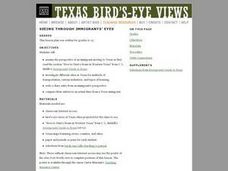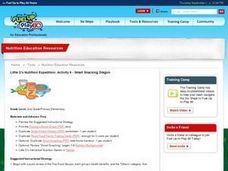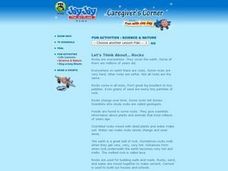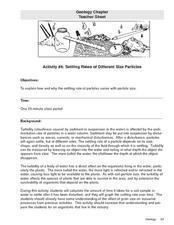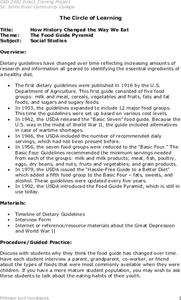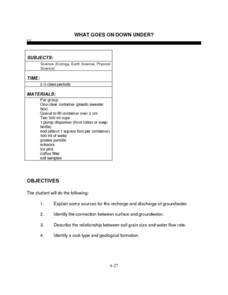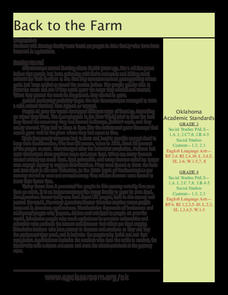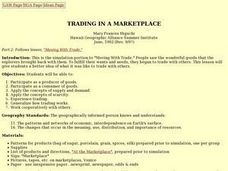Curated OER
Paste Papers
Young scholars combine acrylics with School Smart Art Paste to paint paper and to explore color mixing.
Curated OER
Seeing through Immigrants' Eyes
Students assume the perspective of an immigrant moving to Texas. They write a diary entry from an immigrant's perspective, describing how they arrived in their new town, what steps they take to get settled, and their feelings about their...
Curated OER
Smart Snacking Dragon
Second graders participate in activities that focus on making healthy snack choices.
Curated OER
Arianna Travels the Orient Express
Fourth graders discuss how they eat when they travel. They resequence a letter that has been separated into pieces. They read the letter aloud, discuss the foods eaten by the writer and analyze whether she ate the right amount of food...
Curated OER
The Riddle of the Playground Cave
Students discuss food groups and combination foods, and solve riddle story.
Curated OER
Durga's Victory: Envisioning Power
Students read a selection about the Hindu deity, Durga. They analyze an image of her and discuss what it means to be "powerful."
Curated OER
Wappo Tools
Third graders explore the materials used by the Wappo tribe used to make tools. They compare and contrast the different types of arrowheads and their uses. With adult supervision, they make arrowheads from obsidian.
Curated OER
Training Table Race
Young scholars investigate the role of the carbohydrates food group in sports performance. The difference between simple and complex carbohydrates, and the performance of cardiovascular activities form the focus of the lesson.
Curated OER
Mission Planning: Earth/Mars Comparisons
Students compare and contrast conditions on Mars to those on our own planet, specifically, their local or regional environments. The physical characteristics, the atmosphere, and other astronomical data is considered.
Curated OER
An International Menu
Students research etymologies using dictionaries. They explore the diverse origins of the common foods they eat after making a list of their favorite foods.
Curated OER
Soil Factors
Eighth graders study the nine soil factors to use in field study and to complete an exam. They learn the components and characteristics of soil.
Curated OER
Where Does Radon Come From?
Middle schoolers discuss the differences between the three types of rocks and how radon can escape from the rocks themselves. They analyze other sources of radon in the environment. They work together to complete an activity and worksheet.
Curated OER
Math: Counting on Others
Students use counting skills to decide who wins the Classroom Winter Games. They use numeral writing and tally marks to keep score. Students have an opportunity to pretend they are competing for medals in the Winter Games while using...
Curated OER
What Does That DNA Molecule Really Look Like???
Students extract DNA from animal liver cells. They separate, collect and describe the appearance from the extracted DNA while role playing as an intern in a city's forensics.
Curated OER
Settling Rates of Different Size Particles
High schoolers discover how and why the settling rate of particles differs with the size of the particles. Using different soil samples, they calculate the amount of time it takes for a sample to settle in water for up to forty minutes....
Curated OER
Land That We Love
Students perform "Land that We Love" using correct posture, correct rhythms, and accurate pitches. Emphasis is also placed on analyzing the purpose and meaning of patriotic songs. Students correctly identify and perform repeats and...
Curated OER
Houses in Japan
First graders compare the everday lives of school-aged children in the United States and Japan by comparing the houses they live in. They discuss how traditional Japanese houses are designed with a feeling of opennes to the outdoors and...
Curated OER
Facts, Feats and Folklore: Spiders
Students review and discuss a variety of sayings, folklore and superstitions about spiders. They discuss this information and choose either an interesting fact or appealing foklore tradition to illustrate.
Curated OER
How History Changed the Way We Eat
Students participate in a lesson plan that is concerned with the history of the food pyramid and how it evolved and changed into its modern state. After being presented with the information they conduct classroom discussions about the...
Curated OER
Fish Diseases
Young scholars discuss sicknesses they have had or come in contact with. They discuss treatments for the diseases on the list. Students discuss illnesses that fish might get along with the symptoms, behavior and treatment.
Curated OER
Exploring the Food and Dining Patterns of Cameroon: Classification Activity
Middle schoolers practice using new vocabulary on the dining practices of Cameroon. Using classification techniques, they put words into different categories. As a class, they review and discuss the answers.
Curated OER
What Goes On Down Under?
Young scholars explore the sources for recharge and discharge of groundwater. They research the connection between surface water and groundwater. Students construct a model of an aquifer and explore recharge and discharge of the aquifer.
Curated OER
Back to the Farm
Read up on farming and ranching and connect this information to your learners' lives. After reading, send class members home to fill out a family tree and trace their family history, focusing on farming and ranching backgrounds. Once...
Curated OER
Trading in a Marketplace
Students complete a trade simulation in a marketplace. In the simulation, they role play the role of producer and consumer of goods and apply the concepts of supply and demand. In groups, they discover how an environment can affect the...
Other popular searches
- Whole Grains
- Bread and Grains
- Cereal Grains
- Food Pyramid Grains
- Difference Between Grains
- Plant Products Grains
- Breakfast Cereal Grains
- Sand Grains
- Foods Meat and Grains
- Igneous Rock Grains
- What Are Grains
- Cooking Grains

